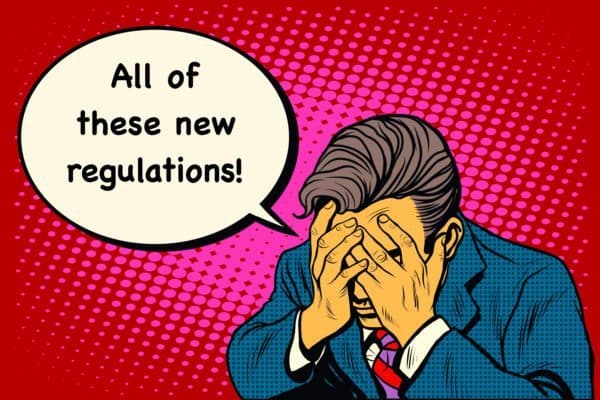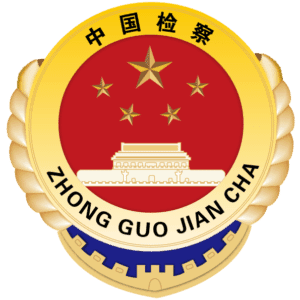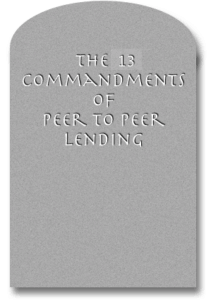
After nearly eight months since the original draft was first issued, the China Banking Regulatory Commission (“CBRC”) announced the official rules for the online lending industry on August 24, 2016. The unveiling came accompanied with a few policy curveballs that few industry participants were expecting. Titled as the “Interim Guidelines” (indicating there could be more permanent policies few years down the road), certain media has hailed the newborn policies as the strictest ever in the history of online lending. However, not much has changed between the draft and final versions with one major exception: borrowers are now subject to a borrowing limit for loans on a single platform as well as across platforms.
Public reactions from industry participants were all positive and supportive as one must never (ever) publicly denounce Chinese policies. Privately, many managers are scrambling to make sense of the new rules while lamenting that regulators have dealt a death blow to the online lending industry.
Rules to Reduce Risk and Police Paperwork
 When Chinese media began circulating rumors of borrowing limits in the days leading up to the official CBRC announcement, many dismissed the reports simply as a rumor. Imagine the disbelief as the policies now confirm that “natural persons may only carry a loan balance of up to RMB 200,000 on a single platform and no more than RMB 1 million across multiple platforms. While legal representatives of organizations and other legal entities may only borrow up to RMB 1 million on a single platform and no more than RMB 5 million across multiple platforms.”
When Chinese media began circulating rumors of borrowing limits in the days leading up to the official CBRC announcement, many dismissed the reports simply as a rumor. Imagine the disbelief as the policies now confirm that “natural persons may only carry a loan balance of up to RMB 200,000 on a single platform and no more than RMB 1 million across multiple platforms. While legal representatives of organizations and other legal entities may only borrow up to RMB 1 million on a single platform and no more than RMB 5 million across multiple platforms.”
In the press conference held by the CBRC, the following official response offers the following explanation for the motivation behind the borrowing limits:
“To better protect lenders’ rights and to reduce the moral hazard risk of lending platforms, we want to limit the concentration risk in loans and work in conjunction with the applicable laws and filing standards for illegal fundraising cases”
The first part of the statement is easy enough to understand, regulators want to forcibly reduce overexposure to large loans as a moral hazard problem does exist in that platforms are incentivized to make bulky loans as it saves them origination costs and helps them generate larger volumes, while lenders ultimately bear the higher risk from overburdened borrowers. The latter part of the statement however is trickier to explain and rationalize.
 According to the relevant rules issued by the Supreme People’s Procuratorate and the Ministry of Public Security, the threshold to establish and prosecute a criminal case for illegal fundraising is RMB 200,000 for individuals and RMB 1 million for organizations. What this means is that if someone illegally fundraises any amount below these thresholds, they will not be prosecuted on a criminal basis and would instead undertake a civil procedure. Therefore the logic here, as one Chinese industry blogger mused, seems to be that all borrowers on lending platforms are now deemed to be fundraising illegally and to protect these borrowers and platforms from criminal prosecution, regulators are enforcing loan limits that match exactly with the criminal case thresholds. In this sense, regulators are attempting to protect lending platforms from being implicated as facilitators in criminal fundraising cases. In addition, drawing a clear line for lending platforms will likely reduce the case load for police departments as platform compliance with the limits would lower the likelihood of criminal cases being filed by lenders. Since the Ministry of Public Security is one of the joint authors of these rules, it has been rumored that they pushed hard for the loan limits so that they can reduce police paperwork from criminal fundraising complaints. This rumor is unverified and highly speculative, of course.
According to the relevant rules issued by the Supreme People’s Procuratorate and the Ministry of Public Security, the threshold to establish and prosecute a criminal case for illegal fundraising is RMB 200,000 for individuals and RMB 1 million for organizations. What this means is that if someone illegally fundraises any amount below these thresholds, they will not be prosecuted on a criminal basis and would instead undertake a civil procedure. Therefore the logic here, as one Chinese industry blogger mused, seems to be that all borrowers on lending platforms are now deemed to be fundraising illegally and to protect these borrowers and platforms from criminal prosecution, regulators are enforcing loan limits that match exactly with the criminal case thresholds. In this sense, regulators are attempting to protect lending platforms from being implicated as facilitators in criminal fundraising cases. In addition, drawing a clear line for lending platforms will likely reduce the case load for police departments as platform compliance with the limits would lower the likelihood of criminal cases being filed by lenders. Since the Ministry of Public Security is one of the joint authors of these rules, it has been rumored that they pushed hard for the loan limits so that they can reduce police paperwork from criminal fundraising complaints. This rumor is unverified and highly speculative, of course.
Alternative Policy Proposal
Allow me to digress here as I would like to propose my own solutions to the issues that regulators pointed to as motivation for implementing the loan limits. If regulators are concerned about concentration risk in large loans, a more direct solution to protect lenders would be to mandate an investment limit per loan, thus forcing lenders to diversify their loan portfolio. Using diversification to reduce risk is frequently advertised to lenders by top lending platforms in both China and the US and should address the regulators’ concern for investor protection. However, if regulators are more focused on the moral hazard of originating large loans that benefit platforms and increase risk to lenders, I think there is an even bigger moral hazard issue that should be addressed first.
Fees.
 Many Chinese lending platforms collect an outrageous amount of origination fees from the borrower. Examining a certain NYSE listed Chinese lending platform’s latest annual financials, one can find an average fee rate of 20%+ being charged to the borrowers. With these fees, the resulting cost to the borrower can soar close to 40% APR, a rate of return that even small time loan sharks will find attractive.
Many Chinese lending platforms collect an outrageous amount of origination fees from the borrower. Examining a certain NYSE listed Chinese lending platform’s latest annual financials, one can find an average fee rate of 20%+ being charged to the borrowers. With these fees, the resulting cost to the borrower can soar close to 40% APR, a rate of return that even small time loan sharks will find attractive.
The classic moral hazard issue here is clear: platforms can overburden borrowers and increase default risk to lenders by collecting high fees that benefit their own financial performance. Even worse, with poor disclosure from the platform, lenders are often only aware of the interest paid to them by the borrower without knowing about the additional fees that borrowers have to pay to the platform.
To resolve this moral hazard problem, I suggest that regulators seriously consider implementing limits on platform fees for borrowers or set a cap on overall borrowing costs. If not, then regulators should at least mandate detailed disclosure of fees on a per loan basis to reduce the information asymmetry between lenders and platforms on borrowing costs for loans.
Although there are existing private lending laws in China regulating the interest rate that lenders can charge borrowers, there are no regulations on the overall borrowing cost inclusive of all fees. Certain platforms have publicly justified the use of this legal loophole to continue to issue high-interest loans under the guise of platform fees. Eventually and hopefully, in one form or another, there must be policies to control fees charged by all types of regulated lending institutions. Otherwise, such irresponsible lending practices will pose a significant risk to China’s financial sector.
Issues with Enforcement
 The main issue with enforcing the loan limits is that China has a severely underdeveloped credit rating system and it is often very difficult to verify a borrower’s debt burden while underwriting a new loan. Regulators and platforms would not only have difficulty in determining the debt situation of a borrower across multiple lending platforms, it will also be challenging determine whether the borrower has outstanding loans across a variety of banks, financial institutions, or individual lenders. Perhaps the new policies would further encourage the industry or other government bodies to develop systems to monitor and share credit information of borrowers.
The main issue with enforcing the loan limits is that China has a severely underdeveloped credit rating system and it is often very difficult to verify a borrower’s debt burden while underwriting a new loan. Regulators and platforms would not only have difficulty in determining the debt situation of a borrower across multiple lending platforms, it will also be challenging determine whether the borrower has outstanding loans across a variety of banks, financial institutions, or individual lenders. Perhaps the new policies would further encourage the industry or other government bodies to develop systems to monitor and share credit information of borrowers.
To further complicate enforcement of the rules, loopholes exist for platforms to circumvent the new policies. Institutions can register multiple entities using different legal representatives and spread out loans across these entities within the policy limits. After all, the “Interim Guidelines” does not stipulate limits on aggregate online loans taken out by related entities with different legal representatives. Similarly, individuals can use spouses, relatives, and friends to borrow on their behalf and the individual as the ultimate user of the funds can serve as the guarantor. The policies were most likely designed with this loopholes in mind as regulators do want to provide some leeway for platforms to operate. Ultimately, it would be up to the local financial regulators tasked with enforcement on how they want to apply the rule within their jurisdiction. Strict interpretation and enforcement on a regional level would most likely induce platforms to migrate their place of registration to jurisdictions that have more lax interpretation of the rules. Thus it would be unlikely for local financial regulators to introduce very strict rules considering the potential detrimental effects on economic activity and tax revenues resulting from platforms migrating to other regions.
Potential Fallout
The borrowing limits would mainly impact Chinese platforms on two levels.
First, there are a few leading platforms in China that have been focused on originating large loans to enterprises of RMB tens and hundreds of millions. These platforms would have to make a drastic adjustment over the 12 month compliance period to reduce their portfolio concentration in these large loans and source borrowers whose capital needs fall within the policy limits. Similarly, companies that have been relying on these large P2P loans will have to find a way to adjust to the new policies or find new financing channels that can satisfy their capital needs. If these companies cannot be successfully weaned off P2P loans, we could witness a wave of defaults and platform collapses at a sizable scale within the year.
On another front, competition will increase for platforms acquiring borrowers that have capital needs that falls within the policy limits. The rise in demand for these small loan borrowers may further drive decreases in the costs of borrowing provided that the supply of credit holds steady. This shift in market dynamics would be very beneficial to borrowers as many still face extremely high all-inclusive costs on loans from P2P platforms in the range of 30 – 40% APR (the majority of the cost coming from fees collected by the platforms). However, it would be interesting to see if platforms would choose to pass on the discounted rates to the lenders or cut into their own margins in order to maintain a healthy lender base and supply of capital.
The Thirteen Commandments
 A list of forbidden activities remain in the announced regulations but in a few adjustments to the original list of 12 items outlined in the draft rules, the final policies now outline the following 13 forbidden activities for online lending platforms:
A list of forbidden activities remain in the announced regulations but in a few adjustments to the original list of 12 items outlined in the draft rules, the final policies now outline the following 13 forbidden activities for online lending platforms:
- Use the platform for self-financing or financing of related parties
- Directly or indirectly accept and manage lender funds
- Provide guarantees to lenders or promise guaranteed returns on principal and interest
- Beyond the approved internet, telecom, and other electronic channels, advertise or recommend loan investments to lenders through physical locations managed by the platform or third parties authorized by the platform
- Directly make loans to borrowers, unless stated otherwise by applicable laws and regulations
- Structure loans into investment products with liquidity timing that differs from the original loan term
- Sell self-managed wealth management or other financial products to accumulate funds or broker bank wealth management products, mutual funds, insurance annuities, or trust products and other financial products
- Conduct securitization like businesses or facilitate the secondary sale and transfer of packaged assets, securitized assets, trust products, or fund interests
- Collaborate with other investment or brokerage businesses to bundle, sell or broker investment products, unless stated otherwise by applicable laws and regulations
- Provide false loan information or exaggerate return expectations; concealing investment risk; use biased language or other fraudulent methods to engage in false advertising or marketing; fabricate and disseminate false or incomplete information to damage the business reputation of another or to mislead borrowers or lenders
- Facilitate loans for the purpose of making investments in the stock market, futures contracts, structured products or other high-risk investments
- Provide equity crowdfunding services
- Other activities forbidden by applicable laws and regulations
The notable addition to this list is rule number 8 that forbids securitization-like services and the secondary sale and transfer of certain assets. It is unclear on what exactly this rule is trying to restrict, but many have interpreted this as an attempt to prevent lending platforms from selling more complicated financial products that are typically controlled by the securities regulator. However, due to the use of Chinese terminology here, a more conservative interpretation of the rule suggests that platforms are not allowed to provide a secondary market for the lenders to trade loans and gain liquidity. Contrary to the US market where a third party provides the secondary loan trading market, the majority of Chinese platforms operate their own secondary market often integrated with the lending platform. Further clarification from the central regulators as well as local regulators will be needed in order to precisely identify the forbidden secondary transfer activities and ultimately, how they will be enforced.
Other Bits
The rest of the new policies remain largely unchanged from the original draft for public opinion. There are a few administrative requirements such as registering with the local financial regulator, updating the business license to include “online lending information intermediary” in the scope of business description, and obtaining an Internet Content Provider license. These tasks may actually be very difficult for platforms to complete as some local government departments have shut the door on processing these requests in fear of inadvertently enabling a platform to conduct fraudulent activity.
The Interim Guidelines also touch upon important policies regarding customer funds custodianship and disclosure standards but deferred details to separate rules that will follow.
Loose Ends – More Regulations to Come
The CBRC Interim Guidelines are just the beginning to a series of applicable laws and regulations for the online lending industry. We can expect more policies and details on the following topics in the near future.
Bank custodianship for customer funds – a draft for public opinion has been circulated by the media in August but I have yet to locate the official copy released on CBRC website. Since I’m unable to confirm the source of the media released copy, I will decline to comment in detail for now. However, it looks like banks will have to step up and provide custodianship for lending platforms. Licensed payment platforms and other third parties would most likely be cut out of the game entirely.
Disclosure standards – the Interim Guidelines outline several pieces of information for disclosure to the public including loan details and performance, platform’s operational performance, audit reports, legal opinions, etc. Detailed disclosure requirements will be covered in a separate set of rules.
Guidelines for local regulators – as platforms are required to register with local financial regulators, the procedural requirements will need to be clarified by the central government. In addition, the current policies stated that local financial regulators will also be required to rate and classify platforms on file, thus a set of rules is expected for the rating process as well.
Regional policies – as provincial governments can make their own detailed rules based on the Interim Guidelines and file with the CBRC, we can also expect to see a variety of regional policies to be released in the near future.
Non-Depository Lending Organization Rules – a draft for public opinion on this topic was issued mid-August prior to the online lending rules. The final policies here will likely have an effect on the activities of lending platforms.
Although the arrival of the Interim Guidelines has finally granted a sense of legitimacy for the online lending industry, new questions have been raised and old questions remain unanswered. However, as with many other nascent industries, regulation for online lending will be a continuous and ever evolving process. We can expect platforms to quickly adapt to the current policies as well as expect many new policies and guidelines from various governing bodies (both local and central) in the months and years to come.
 Spencer Ang Li has served as Fincera’s Vice President of Product since June 2015 and as Chief Executive Officer for Fincera’s multiple product development subsidiaries since March 2014. Prior to joining Fincera, Mr. Li was an Investment Banking Analyst at Cogent Partners in New York, a sell-side advisor for private equity secondary transactions, from 2011 to 2014. During his tenure at Cogent, Mr. Li conducted fund due diligence, managed marketing processes, and participated in the sale and transfer of nearly $2 billion in limited partnership interests on behalf of public pensions, large regional banks, asset managers, and other financial institutions. Mr. Li received a BS in Economics and BA in Psychology from Duke University in 2011.
Spencer Ang Li has served as Fincera’s Vice President of Product since June 2015 and as Chief Executive Officer for Fincera’s multiple product development subsidiaries since March 2014. Prior to joining Fincera, Mr. Li was an Investment Banking Analyst at Cogent Partners in New York, a sell-side advisor for private equity secondary transactions, from 2011 to 2014. During his tenure at Cogent, Mr. Li conducted fund due diligence, managed marketing processes, and participated in the sale and transfer of nearly $2 billion in limited partnership interests on behalf of public pensions, large regional banks, asset managers, and other financial institutions. Mr. Li received a BS in Economics and BA in Psychology from Duke University in 2011.

